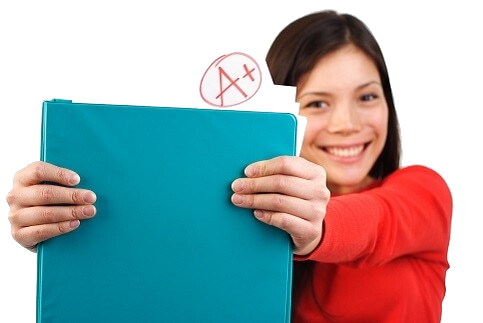Physics > AS Mark Scheme > GCE Physics A H156/02: Depth in physics Advanced Subsidiary GCE Mark Scheme for November 2020 (All)
GCE Physics A H156/02: Depth in physics Advanced Subsidiary GCE Mark Scheme for November 2020
Document Content and Description Below
GCE Physics A H156/02: Depth in physics Advanced Subsidiary GCE Mark Scheme for November 2020 Oxford Cambridge and RSA Examinations GCE Physics A H156/02: Depth in physics Advanced Subsid... iary GCE Mark Scheme for November 2020Oxford Cambridge and RSA Examinations OCR (Oxford Cambridge and RSA) is a leading UK awarding body, providing a wide range of qualifications to meet the needs of candidates of all ages and abilities. OCR qualifications include AS/A Levels, Diplomas, GCSEs, Cambridge Nationals, Cambridge Technicals, Functional Skills, Key Skills, Entry Level qualifications, NVQs and vocational qualifications in areas such as IT, business, languages, teaching/training, administration and secretarial skills. It is also responsible for developing new specifications to meet national requirements and the needs of students and teachers. OCR is a not-for-profit organisation; any surplus made is invested back into the establishment to help towards the development of qualifications and support, which keep pace with the changing needs of today’s society. This mark scheme is published as an aid to teachers and students, to indicate the requirements of the examination. It shows the basis on which marks were awarded by examiners. It does not indicate the details of the discussions which took place at an examiners’ meeting before marking commenced. All examiners are instructed that alternative correct answers and unexpected approaches in candidates’ scripts must be given marks that fairly reflect the relevant knowledge and skills demonstrated. Mark schemes should be read in conjunction with the published question papers and the report on the examination. © OCR 2020H156/02 Mark Scheme November 2020 2 Here are the subject specific instructions for this question paper. CATEGORISATION OF MARKS The marking schemes categorise marks on the MACB scheme. M marks These are method marks upon which A-marks (accuracy marks) later depend. For an M-mark to be scored, the point to which it refers must be seen in the candidate’s answers. If a candidate fails to score a particular M-mark, then none of the dependent A-marks can be scored. A marks These are accuracy or answer marks, which either depend on an M-mark, or allow a C-mark to be scored. C marks These are compensatory method marks which can be scored even if the points to which they refer are not written down by the candidate, providing subsequent working gives evidence that they must have known it. For example, if an equation carries a C-mark and the candidate does not write down the actual equation but does correct working which shows the candidate knew the equation, then the C-mark is given. B marks These are awarded as independent marks, which do not depend on other marks. For a B-mark to be scored, the point to which it refers must be seen specifically in the candidate’s answers. SIGNIFICANT FIGURES If the data given in a question is to 2 sf, then allow an answer to 2 or more significant figures. If an answer is given to fewer than 2 sf, then penalise once only in the entire paper. Any exception to this rule will be mentioned in the Guidance.H156/02 Mark Scheme November 2020 3 Annotations Annotation Meaning Correct response Used to indicate the point at which a mark has been awarded (one tick per mark awarded). Incorrect response Used to indicate an incorrect answer or a point where a mark is lost. AE Arithmetic error Do not allow the mark where the error occurs. Then follow through the working/calculation giving full subsequent ECF if there are no further errors. BOD Benefit of doubt given Used to indicate a mark awarded where the candidate provides an answer that is not totally satisfactory, but the examiner feels that sufficient work has been done. BP Blank page Use BP on additional page(s) to show that there is no additional work provided by the candidates. CON Contradiction No mark can be awarded if the candidate contradicts himself or herself in the same response. ECF Error carried forward Used in numerical answers only, unless specified otherwise in the mark scheme. Answers to later sections of numerical questions may be awarded up to full credit provided they are consistent with earlier incorrect answers. Within a question, ECF can be given for AE, TE and POT errors but not for XP. L1 Level 1 L1 is used to show 2 marks awarded and L1^ is used to show 1 mark awarded. L2 Level 2 L2 is used to show 4 marks awarded and L2^ is used to show 3 marks awarded. L3 Level 3 L3 is used to show 6 marks awarded and L3^ is used to show 5 marks awarded. POT Power of 10 error This is usually linked to conversion of SI prefixes. Do not allow the mark where the error occurs. Then follow through the working/calculation giving ECF for subsequent marks if there are no further errors. SEEN Seen To indicate working/text has been seen by the examiner. SF Error in number of significant figures Where more SFs are given than is justified by the question, do not penalise. Fewer significant figures than necessary will be considered within the mark scheme. Penalised only once in the paper. TE Transcription error This error is when there is incorrect transcription of the correct data from the question, graphical read-off, formulae booklet or a previous answer. Do not allow the relevant mark and then follow through the working giving ECF for subsequent marks. XP Wrong physics or equation Used in numerical answers only, unless otherwise specified in the mark scheme. Use of an incorrect equation is wrong physics even if it happens to lead to the correct answer. ^ Omission Used to indicate where more is needed for a mark to be awarded (what is written is not wrong but not enough).H156/02 Mark Scheme November 2020 4 Abbreviations, annotations and conventions used in the detailed Mark Scheme (to include abbreviations and subject-specific conventions). Annotation Meaning / alternative and acceptable answers for the same marking point Reject Answers which are not worthy of credit Not Answers which are not worthy of credit Ignore Statements which are irrelevant Allow Answers that can be accepted ( ) Words which are not essential to gain credit ___ Underlined words must be present in answer to score a mark ECF Error carried forward AW Alternative wording ORA Or reverse argumentH156/02 Mark Scheme November 2020 5 Question Answer Marks Guidance 1 (a) (i) Vibrations or oscillations parallel to direction of travel of the wave / direction of energy transfer B1 (ii) Amplitude of 2 cm (in each direction) Sinusoidal shape (by eye) with period of 4 cm – at least two waves B1 B1 Check peak, equilibrium and trough positions (b) (i) Microwave: 2 cm X-ray 200 pm B1 B1 (ii) Any two from: May be reflected / refracted / diffracted / interference May be polarised Travel in a vacuum (at a constant speed / 3 x 108 m s-1) Oscillation of electric and magnetic fields. B1 x 2 Allow speed of light Total 7H156/02 Mark Scheme November 2020 6 Question Answer Marks Guidance 2 (a) (i) (f = v/λ) = 3.00 × 108 ÷ 4.69 × 10-7 (= 6.40 x 1014 Hz) B1 6.397 x 1014 Hz (ii) 1.96 × 108 (ms-1) 3.07 × 10-7 (m) B1 B1 Allow 3.06 × 10-7 (m) (uses (i)) Not ECF for incorrect speed (b) (i) 1. p = 30° B1 2. sin q = 0.5 × 1.53 or 0.765 q = 50° C1 A1 Allow 49.9° Note 19 ° does not score (ii) p always equals i or p increases with i / when i = 60°, p = 60° Any three from: as i increases, q increases (until i equals the critical angle) when i = critical angle, q = 90° critical angle = 41° when i is greater than critical angle, total internal reflection occurs when i = 60°, there is no angle q or no refracted ray B1 B1 x3 Not q = 0 (c) Straight line to centre of block and reflects along original ray P Straight line to centre of block and refracts with angle q less than 49.9° but greater than 30° B1 B1 Total 12H156/02 Mark Scheme November 2020 7 Question Answer Marks Guidance 3 (a) (i) points on the line read to the nearest half square size of triangle is greater than half the length of the drawn line and Δy / Δx B1 B1 Allow Δy for y2 – y1 and Δx for x2 – x1 Δx ≥ 0.1625 (ii) �09..12 81� = 81.75 82 N m-1 given to 2 or 3 significant figures C1 A1 Allow ECF from (a)(i) Allow 81.8 N m-1 Note POT must be correct for given unit Allow kg s–2 (b) (i) steepest or shallowest line that passes through all the error bars B1 (ii) gradient determined: 0.10 mkg-1or 0.13 mkg-1 B1 Allow ECF from (b)(i) (iii) ∆gradient (0.13 - 0.12 or 0.12 - 0.10) ∆gradient gradient × 100 = 8.3% or 17% OR ∆� (82 – 75 or 98-82) ∆� � × 100 = 8.5% or 20% C1 A1 C1 A1 Allow ECF from (b)(i) and (ii) Not 10% without justification Total 8H156/02 Mark Scheme November 2020 8 Question Answer Marks Guidance 4 Level 3 (5–6 marks) Detailed procedure including labelled diagram and measurements to be taken and detailed analysis There is a well-developed line of reasoning which is clear and logically structured. The information presented is relevant and substantiated. Level 2 (3–4 marks) A diagram, some procedure, some measurements and some analysis or detailed analysis and limited procedure with limited diagram or detailed procedure including diagram and measurements to be taken and limited analysis There is a line of reasoning presented with some structure. The information presented is in the most-part relevant and supported by some evidence. Level 1 (1–2 marks) Limited procedure and limited measurements or limited analysis There is an attempt at a logical structure with a line of reasoning. The information is in the most part relevant. 0 marks No response or no response worthy of credit. B1 x 6 Indicative scientific points may include: Diagram and procedure • labelled diagram • horizontal surface supported • description of procedure • method to release ball • method to identify position ball hits the ground • repeats experiment for each v • method to prevent ball rolling on floor in laboratory Measurements • measuring instruments to determine v • measurements to determine v e.g. mgh conversion or one light gate with diameter of ball measured or two light gates with distance between light gates measured • use of ruler to measure R. Analysis • equation to determine v • appropriate graph, e.g. plot R against v or plot R2 against v2 • Expect straight line passing through origin • Q = g x gradient2 or Q = g x gradient Total 6H156/02 Mark Scheme November 2020 9 Question Answer Marks Guidance 5 (a) 20 (m s-1) B1 (b) (After 0.75 s) gradient decreases with time Indicating velocity is decreasing/ deceleration M1 A1 (c) Tangent drawn at t = 1.75 s (judge by eye) Gradient in the range 11.0 (m s-1) to 13.0 (m s-1) B1 B1 (d) ∆time = 1.75 – 0.75 OR 3.25 - 0.75 Using (c):� = 950 × 20−12 1.75−0.75 or using graph:� = 950× 20 −0 3.25−0.75 or � = 950×20 3.25−0.75 7600 (N) C1 C1 A1 Allow use of (c) and (a) Allow a= 8.0 m s-2 for v2=u2+2as or s=ut+ ½at2 methods Not ECF for incorrect time Ignore sign (e) Maximum of two from: (thinking) time is the same (braking) time is halved / 1.25 s total time is 2 s AND maximum of two from: (thinking) distance / displacement travelled (before braking) halved / 7.5 m (braking) distance / displacement quarters / 6.25 m total distance / displacement = 13.75 m B1 x 3 Total 11H156/02 Mark Scheme November 2020 10 Question Answer Marks Guidance 6 (a) � × �32×10−3�2 4 × 100 × 10−3 or 8.04× 10−5 7 .0 9.81 or 0.714 8900 (kg m-3) C1 C1 A1 Ignore POT 8881 2200 scores two marks (b) (i) 4.4 – 4.6 (N) B1 (ii) Weight of cylinder 3.5 cm vertically (judge by eye) Correct closed triangle drawn including TA Correct directions indicated for weight and TA and TA = 6.4 ± 0.2 (N) M1 M1 A1 (iii) 39 ± 1° A1 Allow ECF from (b)(ii) for trigonometry methods (c) F x 100 or 7.0 x 16 � = 7.0 � 16 100 = 1.1 (N) C1 A1 Ignore POT 1.12 Not 1.067 Total 10H156/02 Mark Scheme November 2020 11 Question Answer Marks Guidance 7 (a) (i) � = 150 1.52 67 Ω C1 A1 Allow � = 150 1 .5 = 100 Vand � = 100 1.5 (ii) Q = 1.5 x 5.0 x 60 x 60 or 27000 � = 1.5×5.0×60×60 1 .6 ×10−19 =1.7 x 1023 C1 A1 Note use of 150 (W) does not score 1.7 x 1025 1.68 x 1023 4.7 x 1019 scores one mark Not 1.7 x 1025 (uses 150 W) (iii) � = 1.5 7.9 × 1028 × 4.1 × 10−9 × 1.6 × 10−19 0.029 (m s-1) C1 A1 (b) 150 (x 10-3) x 5 x 16 12 (p) C1 A1 Not time in minutes or seconds Allow ECF for POT on power (c) Silicon will have a smaller number density, ORA Silicon will have a larger resistivity, ORA B1 B1 Allow semiconductor for silicon; metal for nichrome Total 10H156/02 Mark Scheme November 2020 Question Answer Marks Guidance 8 Level 3 (5–6 marks) Description and explanation of pattern changes and quantitatively explains link between de Broglie wavelength and potential difference. There is a well-developed line of reasoning which is clear and logically structured. The information presented is relevant and substantiated. Level 2 (3–4 marks) Clear description of how pattern changes and explanation of pattern changes and qualitatively explains link between de Broglie wavelength and potential difference or limited description of how pattern changes and quantitatively explains link between de Broglie wavelength and potential difference. There is a line of reasoning presented with some structure. The information presented is in the most-part relevant and supported by some evidence. Level 1 (1–2 marks) Limited description of how pattern changes and limited attempts to explain qualitatively the link between de Broglie wavelength and potential difference or qualitatively explains link between de Broglie wavelength and potential difference. The information is basic and communicated in an unstructured way. The information is supported by limited evidence and the relationship to the evidence may not be clear. 0 marks No response or no response worthy of credit. B1 x 6 Indicative scientific points may include: Description of pattern changes • Rings become closer (not just smaller) • Rings become brighter Qualititative explanation of pattern changes in terms of de Broglie wavelength and potential difference • Electrons gain greater energy • Electrons have a greater speed • Electrons have a greater momentum • Implies smaller wavelength • Smaller wavelength means less diffraction • Shorter wavelength gives shorter path differences between areas of constructive and destructive interference Quantitative explanation of pattern changes in terms of de Broglie wavelength and potential difference • �� = 1 2 �� 2 • � = �� • v2 α V or p2 α V • � = ℎ � or � α 1 � • � = ℎ √2��� or � ∝ √1�OCR (Oxford Cambridge and RSA Examinations) The Triangle Building Shaftesbury Road Cambridge CB2 8EA OCR Customer Contact Centre Education and Learning Telephone: 01223 553998 d [Show More]
Last updated: 1 year ago
Preview 1 out of 14 pages

Reviews( 0 )
Recommended For You
Chemistry> AS Mark Scheme > OCR GCE Chemistry AH032/02: Depth in chemistry Advanced Subsidiary GCE Mark Scheme for Autumn 2021 (All)
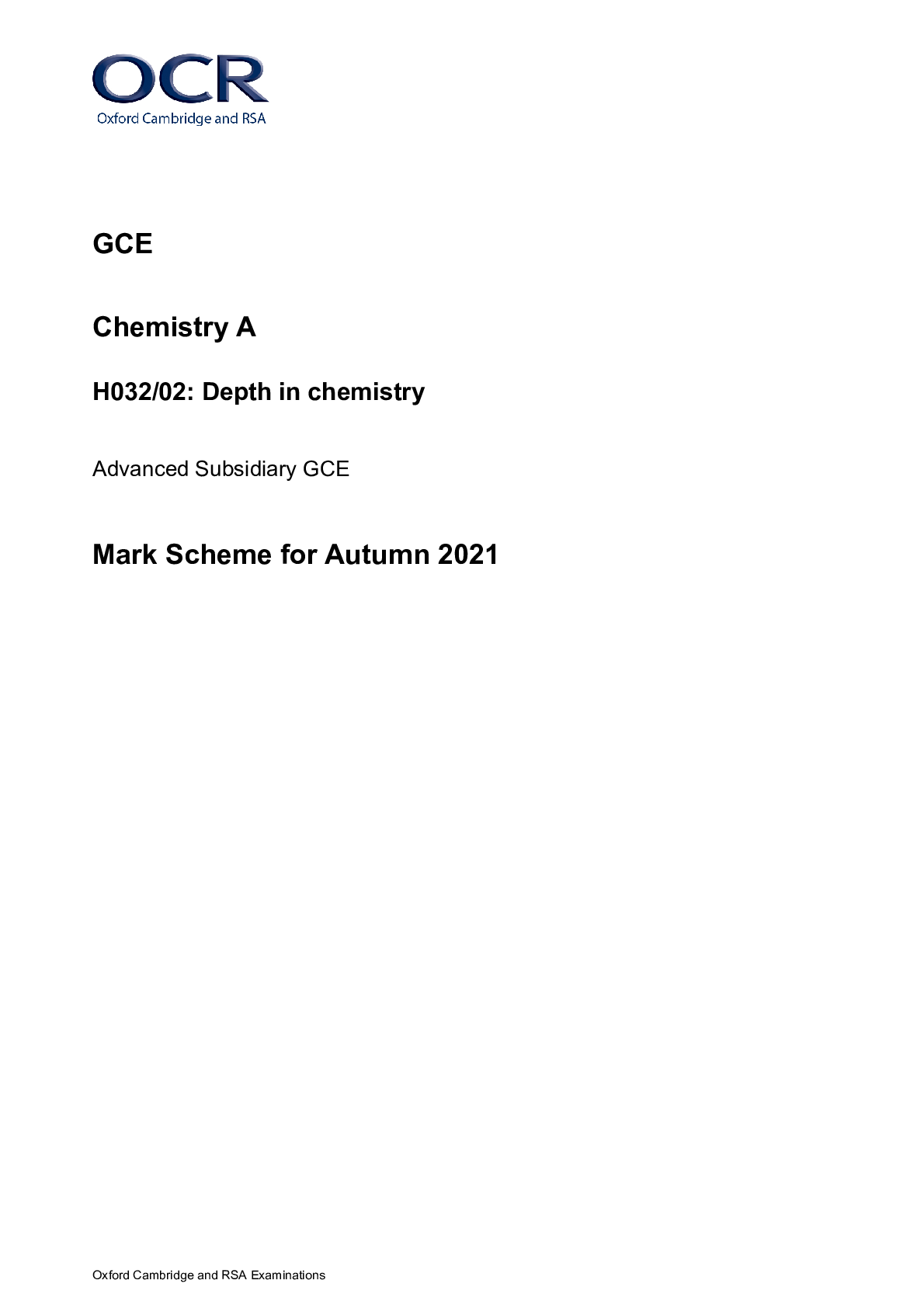
OCR GCE Chemistry AH032/02: Depth in chemistry Advanced Subsidiary GCE Mark Scheme for Autumn 2021
OCR GCE Chemistry AH032/02: Depth in chemistry Advanced Subsidiary GCE Mark Scheme for Autumn 2021
By markstudys , Uploaded: Jul 03, 2022
$8
Biology> AS Mark Scheme > > GCE Biology A H020/01: Breadth in biology Advanced Subsidiary GCE Mark Scheme for Autumn 2021 (All)
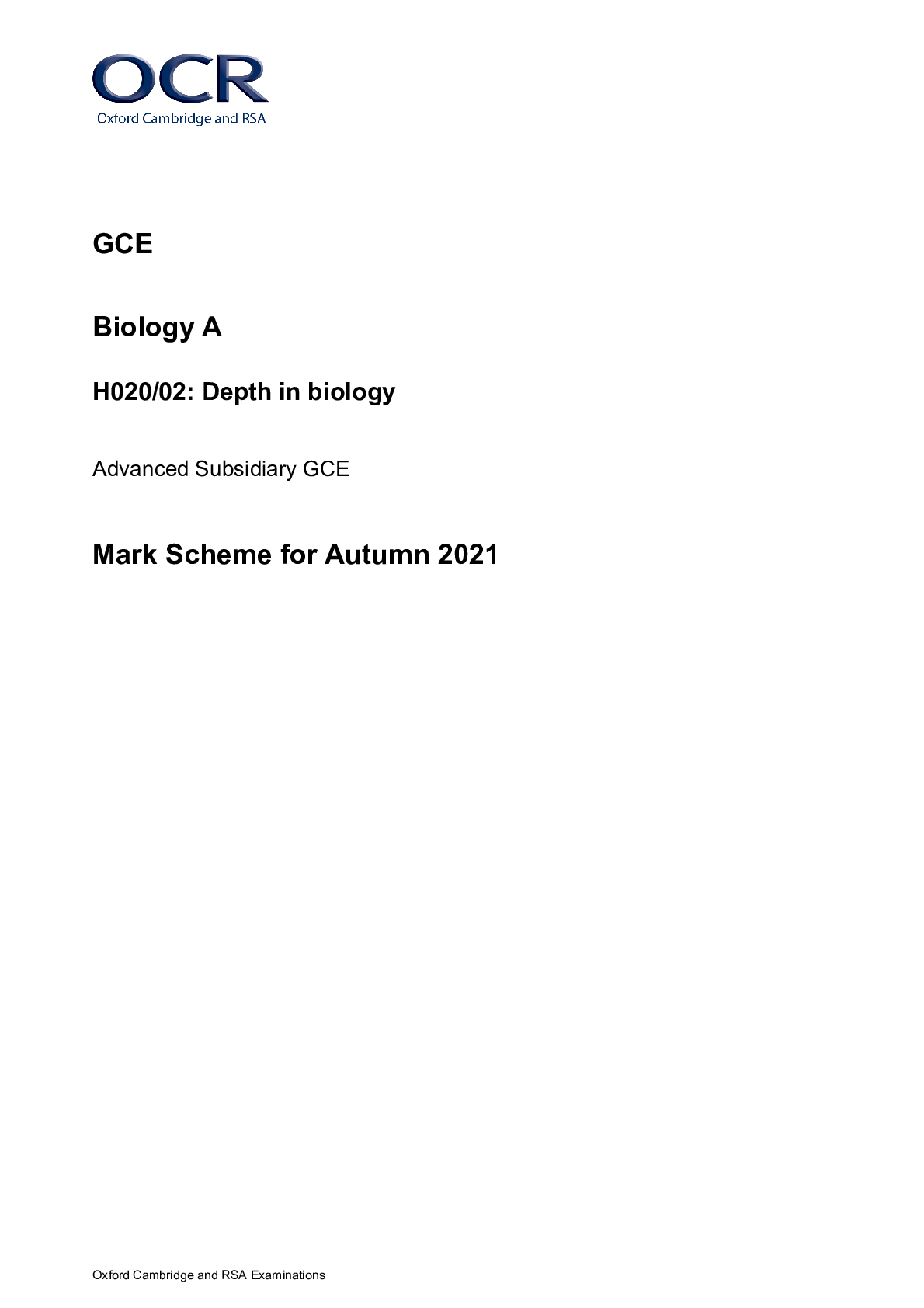
> GCE Biology A H020/01: Breadth in biology Advanced Subsidiary GCE Mark Scheme for Autumn 2021
OCR GCE Biology A H020/01: Breadth in biology Advanced Subsidiary GCE Mark Scheme for Autumn 2021
By Prof.Pierro , Uploaded: Jun 16, 2022
$7.5
Biology> AS Mark Scheme > > GCE Biology A H020/02: Depth in biology Advanced Subsidiary GCE Mark Scheme for Autumn 2021 (All)

> GCE Biology A H020/02: Depth in biology Advanced Subsidiary GCE Mark Scheme for Autumn 2021
OCR GCE Biology A H020/02: Depth in biology Advanced Subsidiary GCE Mark Scheme for Autumn 2021
By Prof.Pierro , Uploaded: Jun 16, 2022
$7.5
Biology> AS Mark Scheme > > GCE Biology A H020/02: Depth in biology Advanced Subsidiary GCE Mark Scheme for Autumn 2021 (All)

> GCE Biology A H020/02: Depth in biology Advanced Subsidiary GCE Mark Scheme for Autumn 2021
OCR GCE Biology A H020/02: Depth in biology Advanced Subsidiary GCE Mark Scheme for Autumn 2021
By Prof.Pierro , Uploaded: Jun 16, 2022
$7.5
Chemistry> AS Mark Scheme > H432/01: Periodic table, elements and physical chemistry Advanced GCE Mark Scheme for November 2020 (All)
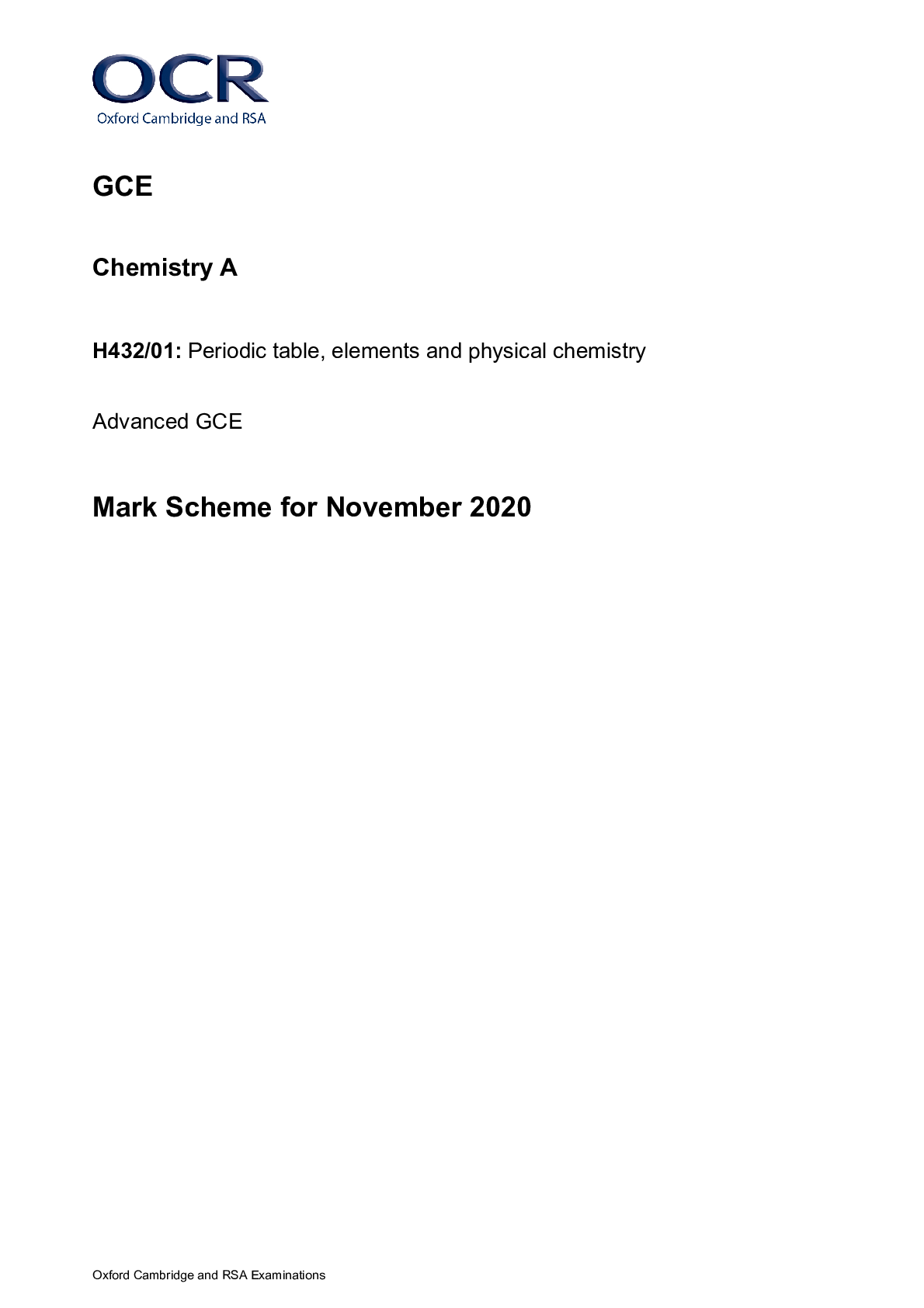
H432/01: Periodic table, elements and physical chemistry Advanced GCE Mark Scheme for November 2020
H432/01: Periodic table, elements and physical chemistry Advanced GCE Mark Scheme for November 2020
By charles , Uploaded: Jan 19, 2022
$7.5
Mathematics> AS Mark Scheme > GCE Mathematics A H230/02: Pure Mathematics and Mechanics Advanced Subsidiary GCE Mark Scheme for Autumn 2021 (All)
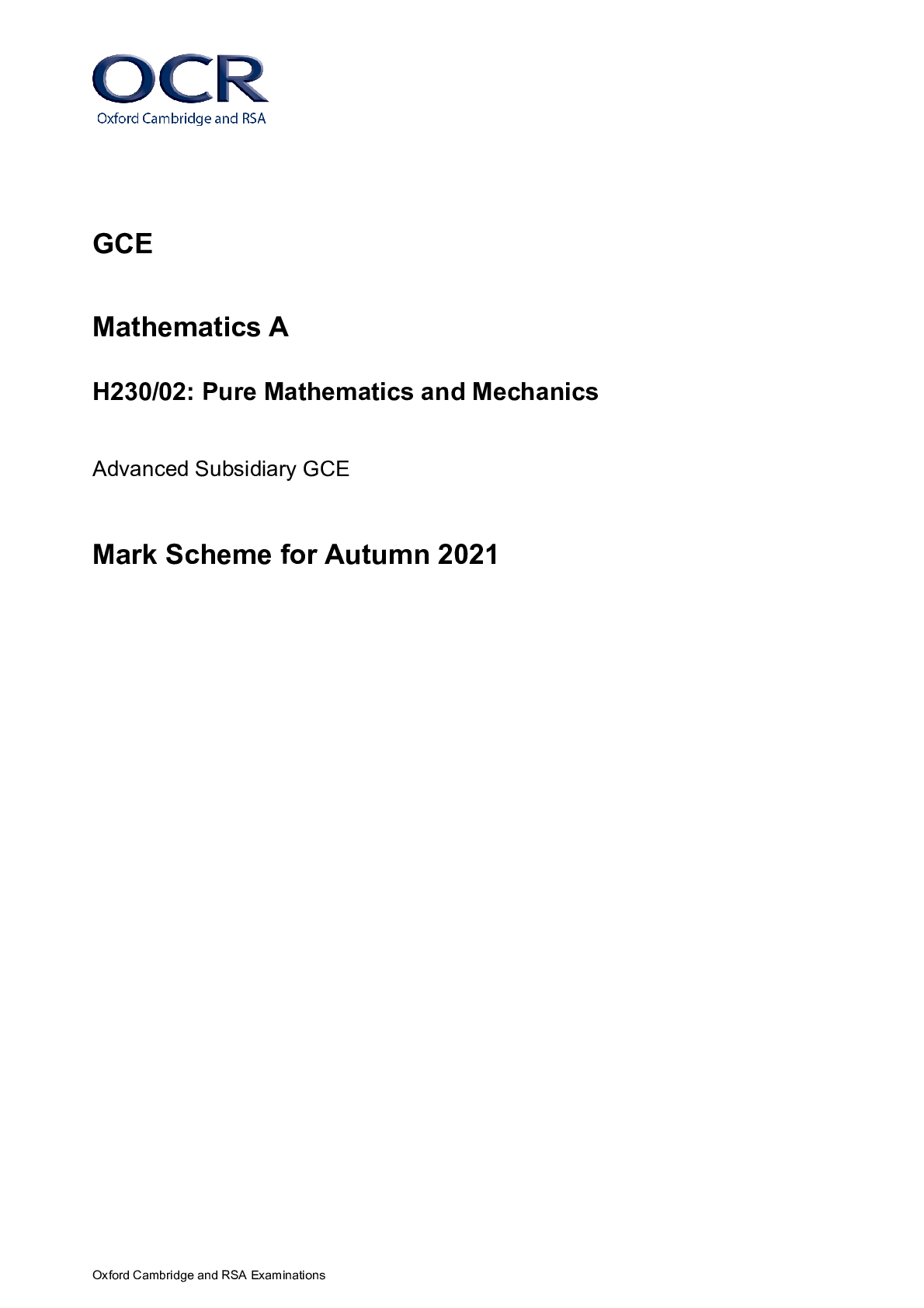
GCE Mathematics A H230/02: Pure Mathematics and Mechanics Advanced Subsidiary GCE Mark Scheme for Autumn 2021
GCE Mathematics A H230/02: Pure Mathematics and Mechanics Advanced Subsidiary GCE Mark Scheme for Autumn 2021
By STUDY-GUIDENOTES , Uploaded: Jan 13, 2022
$12
History> AS Mark Scheme > GCE History A Y112/01: Britain 1900-1951 Advanced GCE Mark Scheme for November 2020 (All)
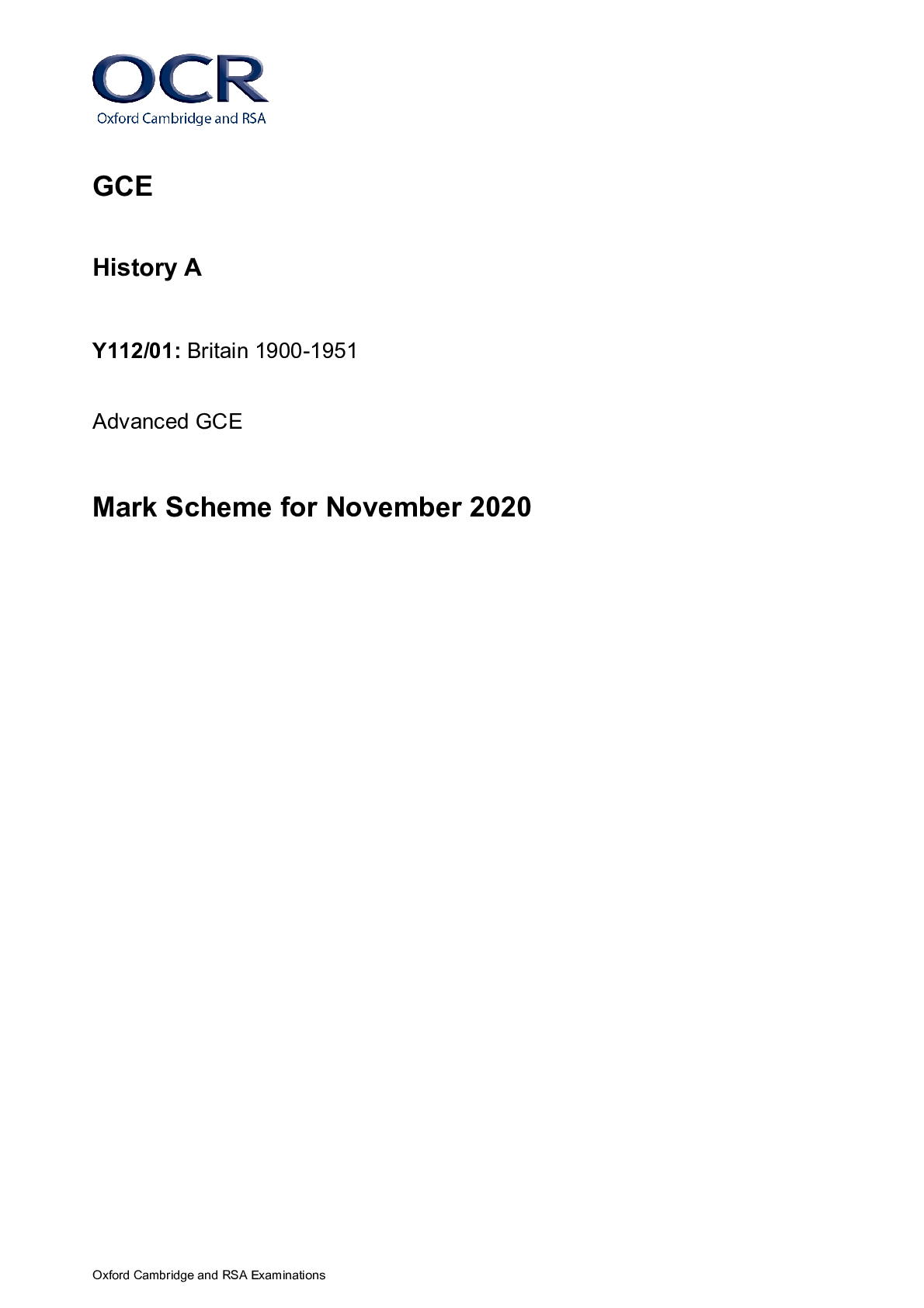
GCE History A Y112/01: Britain 1900-1951 Advanced GCE Mark Scheme for November 2020
Oxford Cambridge and RSA Examinations GCE History A Y112/01: Britain 1900-1951 Advanced GCE Mark Scheme for November 2020Oxford Cambridge and RSA Examinations OCR (Oxford Cambridge and RSA) is a...
By Bobweiss , Uploaded: Oct 10, 2022
$7.5
History> AS Mark Scheme > GCE History A Y113/01: Britain 1930-1997 Advanced GCE Mark Scheme for November 2020 (All)
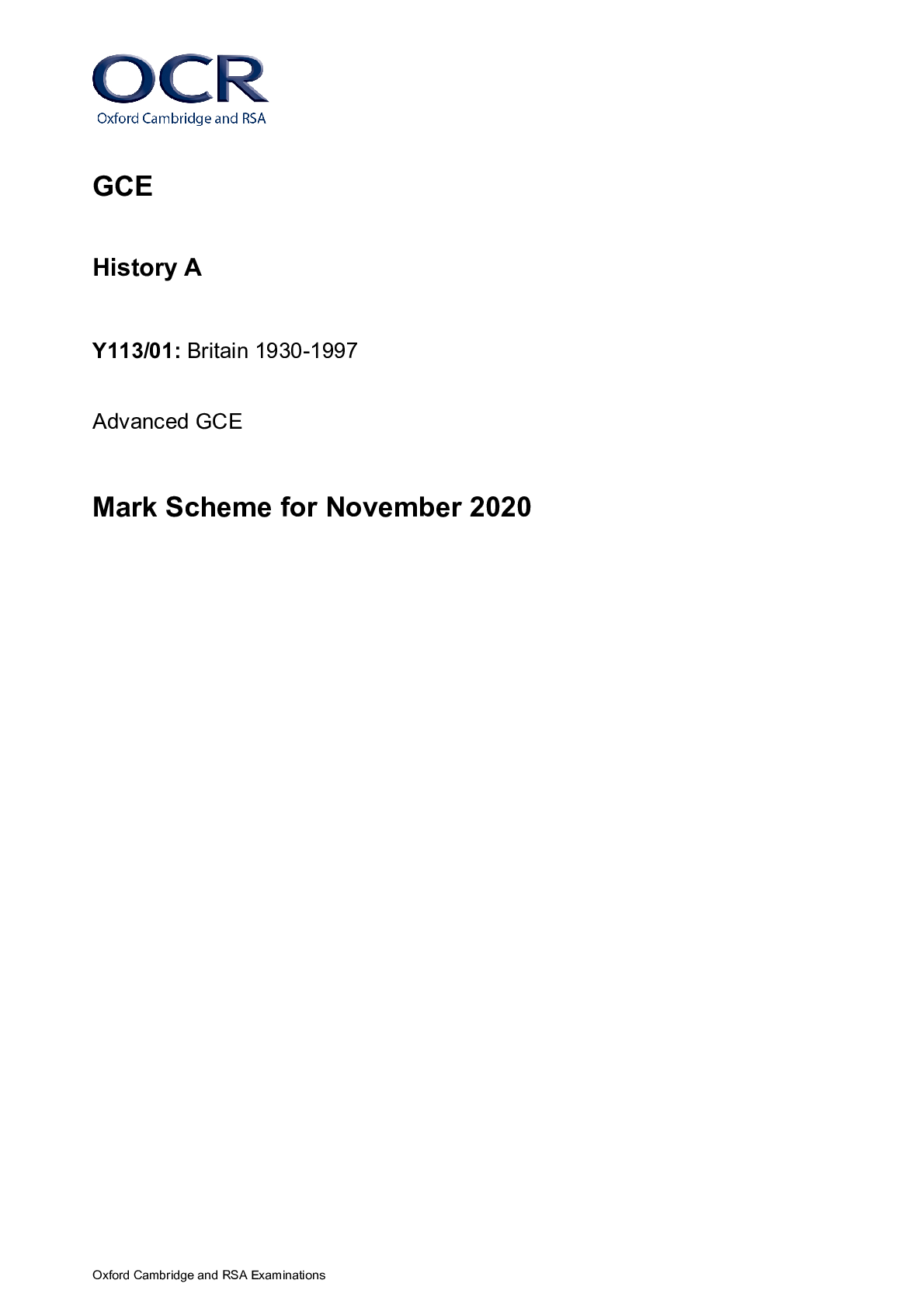
GCE History A Y113/01: Britain 1930-1997 Advanced GCE Mark Scheme for November 2020
Oxford Cambridge and RSA Examinations GCE History A Y113/01: Britain 1930-1997 Advanced GCE Mark Scheme for November 2020Oxford Cambridge and RSA Examinations OCR (Oxford Cambridge and RSA) is a...
By Bobweiss , Uploaded: Oct 10, 2022
$7.5
History> AS Mark Scheme > GCE History A Y143/01: Britain 1930-1997 Advanced Subsidiary GCE Mark Scheme for November 2020 (All)
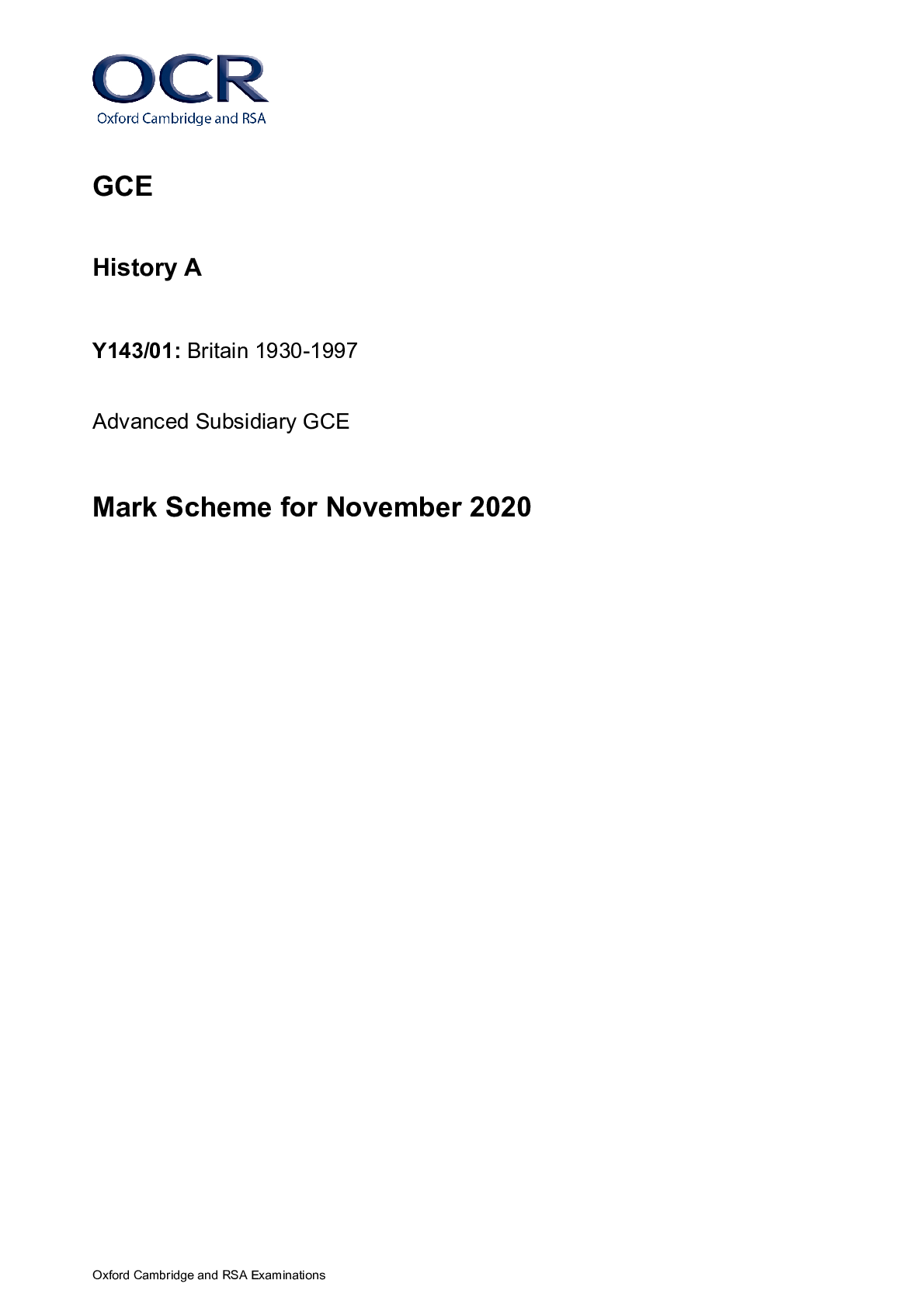
GCE History A Y143/01: Britain 1930-1997 Advanced Subsidiary GCE Mark Scheme for November 2020
Oxford Cambridge and RSA Examinations GCE History A Y143/01: Britain 1930-1997 Advanced Subsidiary GCE Mark Scheme for November 2020Oxford Cambridge and RSA Examinations OCR (Oxford Cambridge an...
By Bobweiss , Uploaded: Oct 10, 2022
$7.5
History> AS Mark Scheme > GCE History A Y203/01: The Crusades and the Crusader States 1095-1192 Advanced GCE Mark Scheme for November 2020 (All)
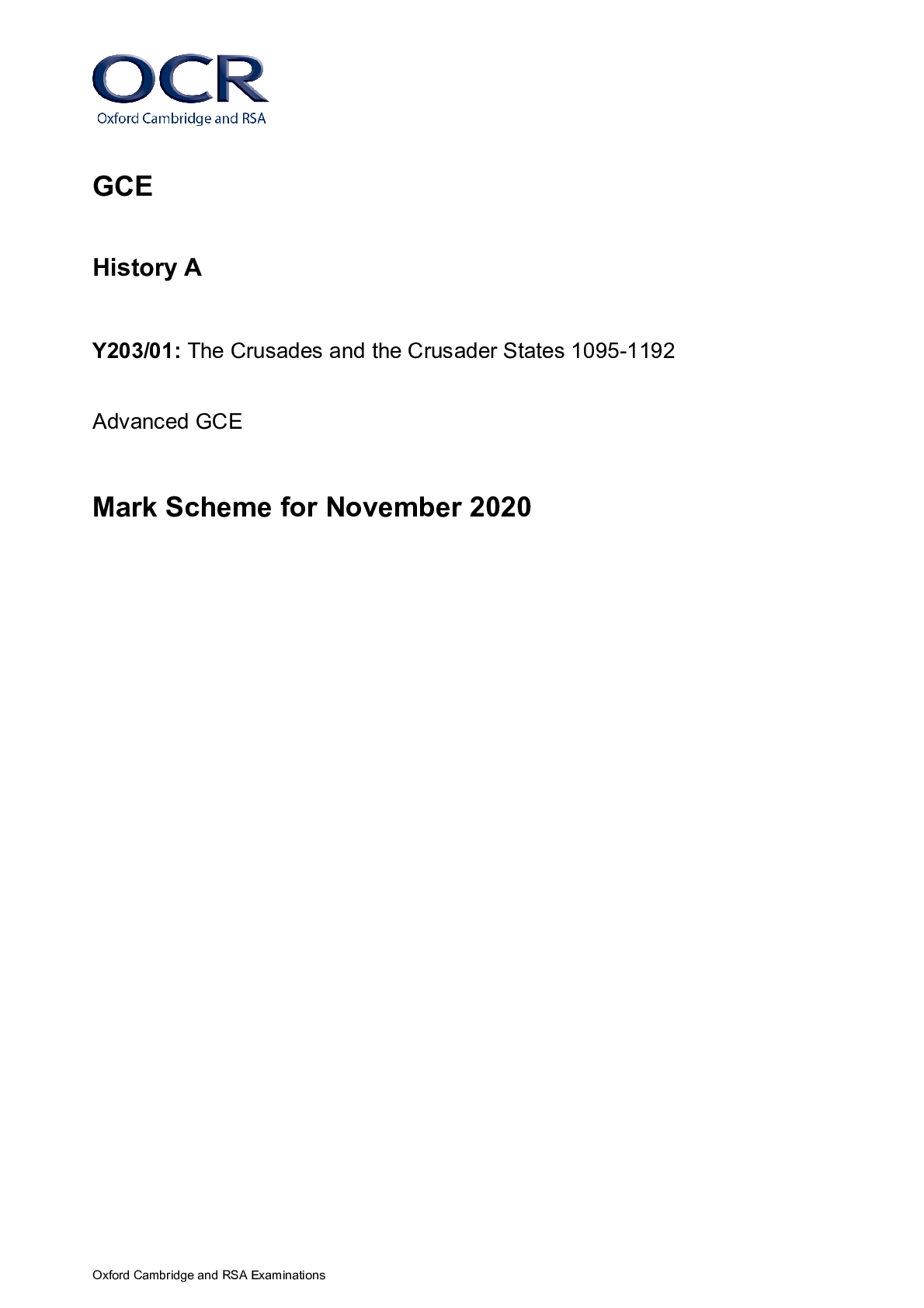
GCE History A Y203/01: The Crusades and the Crusader States 1095-1192 Advanced GCE Mark Scheme for November 2020
Oxford Cambridge and RSA Examinations GCE History A Y203/01: The Crusades and the Crusader States 1095-1192 Advanced GCE Mark Scheme for November 2020Oxford Cambridge and RSA Examinations OCR (O...
By Bobweiss , Uploaded: Oct 10, 2022
$7.5
Document information
Connected school, study & course
About the document
Uploaded On
Oct 07, 2022
Number of pages
14
Written in
Additional information
This document has been written for:
Uploaded
Oct 07, 2022
Downloads
0
Views
49


